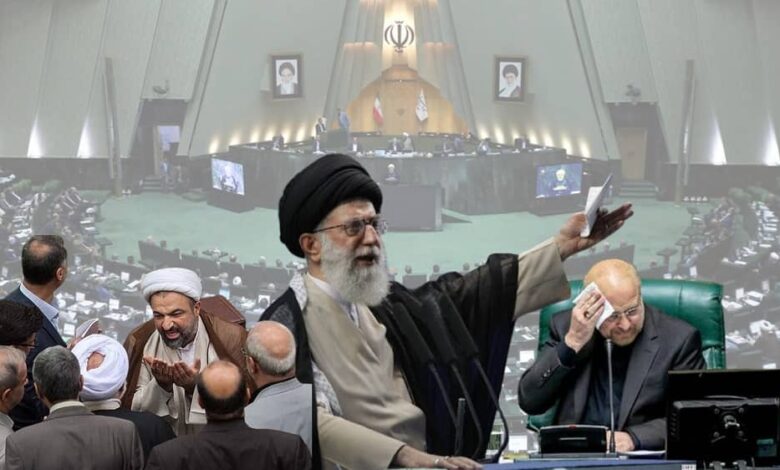Analyzing Ghalibaf’s Standoff for Iran’s Parliament Speakership

Written by
Mehdi Oghbai
iran majlis parliament rasaee ghalibaf khamenei
Two-minute read
In the labyrinth of Iran’s political landscape, Mohammad Bagher Ghalibaf finds himself at a critical juncture. The once-unassailable Speaker of the regime’s Parliament now faces mounting challenges to his leadership, signaling a potential shift in the country’s power dynamics.
Recent leaks from parliamentary servers have shed light on Ghalibaf’s proactive role in advancing legislative measures and budgets sought by the Supreme Leader’s Office and the Islamic Revolutionary Guard Corps. However, despite his efforts, internal strife with Ebrahim Raisi’s government paints Ghalibaf as a significant disruptor in Khamenei’s pursuit of absolute conformity in governance.
Hence, the parliamentary elections on March 1 served as a tool to undermine Ghalibaf’s political standing, marked by a significant decrease in his electoral backing, relegating him to a distant fourth position in Tehran. This decline, coupled with the emergence of anti-Ghalibaf factions in the prospective composition of the Majlis, prompts crucial inquiries regarding the sustainability of his speakership.
The narrative of Ghalibaf’s political trajectory is emblematic of the evolving dynamics within the regime’s extremist circles. Once hailed as the torchbearer of Khamenei’s roadmap, Ghalibaf now finds himself at odds with erstwhile allies, particularly factions aligned with the Paydari Front.
The fissures within the regime’s extremist bloc, those who identify themselves as principlists, came to the fore during the 2017 presidential sham elections, where conflicting interests laid bare the fault lines within the camp that is closest to the Supreme Leader. The subsequent parliamentary elections of 2020 further deepened these fault lines, leading to a rupture between Ghalibaf and the Paydari Front.
The rise of figures such as Hamid Rasaee, Amirhossein Sabeti, and Mahmoud Nabavian signals a seismic shift in Tehran’s political calculus, one that promises to redefine the contours of power within the regime’s legislative arm.
Watch and judge how #IranRevolution has intensified internal strife in the #Iranian regime pic.twitter.com/arCJuckShF
— NCRI-FAC (@iran_policy) December 24, 2023
While Khamenei had warned against discord and political disputes in his first public address after the March 1 elections, Hamid Rasaee, a sitting MP and a significant figure in the regime’s forthcoming parliament, accused Ghalibaf of corruption on state television a few days later, seemingly to undercut his position.
The regime’s Supreme Leader Khamenei had aimed to exploit the self-inflicted turmoil in the Middle East to disrupt the domestic balance against a restive society as well as the disobedient among the ruling elite. By increasing executions, first and foremost he wanted to orchestrate a high turnout sham elections to convey the message to the world that the fire of the 2022 uprising has lied down and it is now business as usual. However, the people of Iran’s landslide boycott proved the exact opposite.
In the corridors of power in Tehran, where political intrigue and power struggles define the contours of political discourse, Ghalibaf’s political future now hangs in the balance. The battle for supremacy between Ghalibaf and his adversaries is emblematic of the broader struggle for political dominance within the regime’s extremist circles and whoever is eventually installed by Khamenei, signals whether he has managed to advance his agenda or has been forced to back down.
Within the clerical dictatorship, the identity of those occupying positions of leadership holds little significance. Almost all former presidents, parliamentary speakers, and even heads of the judiciary of this regime, who were once considered staunch allies of Khamenei, have either fallen out of favor with him or are now no longer alive. Regardless of their ascent up the ladder of power, they have ultimately been marginalized. As Khamenei strives to cleanse his regime, he unwittingly destabilizes its very foundation and governance.

